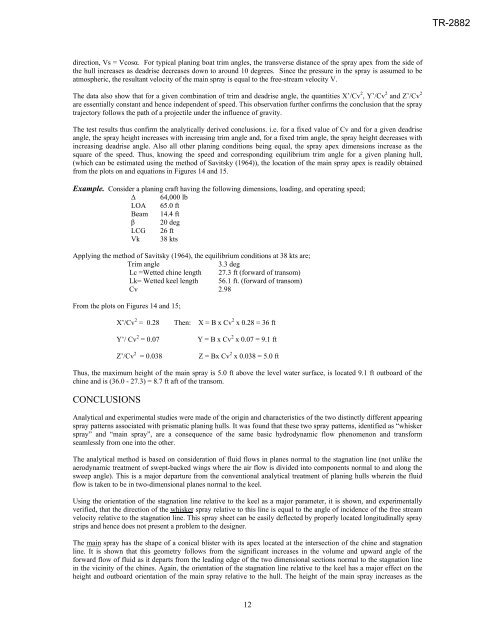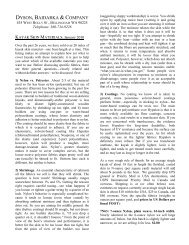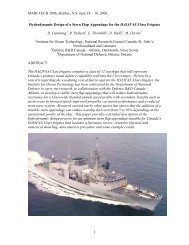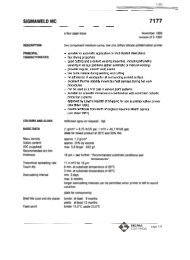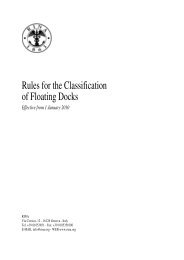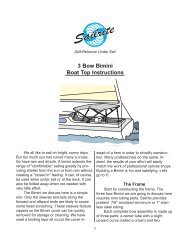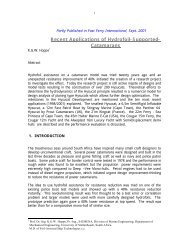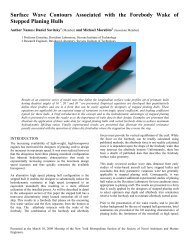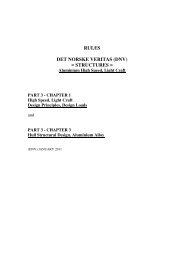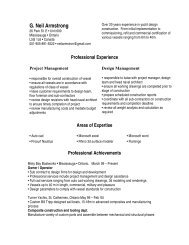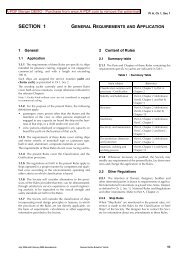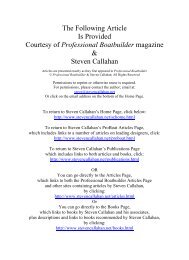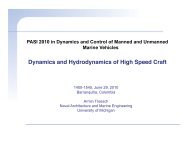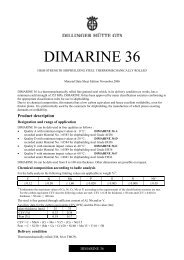Origin and Characteristics of the Spray Patterns TR-2882 3-10 ...
Origin and Characteristics of the Spray Patterns TR-2882 3-10 ...
Origin and Characteristics of the Spray Patterns TR-2882 3-10 ...
You also want an ePaper? Increase the reach of your titles
YUMPU automatically turns print PDFs into web optimized ePapers that Google loves.
<strong>TR</strong>-<strong>2882</strong><br />
direction, Vs = Vcosα. For typical planing boat trim angles, <strong>the</strong> transverse distance <strong>of</strong> <strong>the</strong> spray apex from <strong>the</strong> side <strong>of</strong><br />
<strong>the</strong> hull increases as deadrise decreases down to around <strong>10</strong> degrees. Since <strong>the</strong> pressure in <strong>the</strong> spray is assumed to be<br />
atmospheric, <strong>the</strong> resultant velocity <strong>of</strong> <strong>the</strong> main spray is equal to <strong>the</strong> free-stream velocity V.<br />
The data also show that for a given combination <strong>of</strong> trim <strong>and</strong> deadrise angle, <strong>the</strong> quantities X’/Cv 2 , Y’/Cv 2 <strong>and</strong> Z’/Cv 2<br />
are essentially constant <strong>and</strong> hence independent <strong>of</strong> speed. This observation fur<strong>the</strong>r confirms <strong>the</strong> conclusion that <strong>the</strong> spray<br />
trajectory follows <strong>the</strong> path <strong>of</strong> a projectile under <strong>the</strong> influence <strong>of</strong> gravity.<br />
The test results thus confirm <strong>the</strong> analytically derived conclusions. i.e. for a fixed value <strong>of</strong> Cv <strong>and</strong> for a given deadrise<br />
angle, <strong>the</strong> spray height increases with increasing trim angle <strong>and</strong>, for a fixed trim angle, <strong>the</strong> spray height decreases with<br />
increasing deadrise angle. Also all o<strong>the</strong>r planing conditions being equal, <strong>the</strong> spray apex dimensions increase as <strong>the</strong><br />
square <strong>of</strong> <strong>the</strong> speed. Thus, knowing <strong>the</strong> speed <strong>and</strong> corresponding equilibrium trim angle for a given planing hull,<br />
(which can be estimated using <strong>the</strong> method <strong>of</strong> Savitsky (1964)), <strong>the</strong> location <strong>of</strong> <strong>the</strong> main spray apex is readily obtained<br />
from <strong>the</strong> plots on <strong>and</strong> equations in Figures 14 <strong>and</strong> 15.<br />
Example. Consider a planing craft having <strong>the</strong> following dimensions, loading, <strong>and</strong> operating speed;<br />
Δ 64,000 lb<br />
LOA 65.0 ft<br />
Beam 14.4 ft<br />
β 20 deg<br />
LCG 26 ft<br />
Vk 38 kts<br />
Applying <strong>the</strong> method <strong>of</strong> Savitsky (1964), <strong>the</strong> equilibrium conditions at 38 kts are;<br />
Trim angle<br />
3.3 deg<br />
Lc =Wetted chine length 27.3 ft (forward <strong>of</strong> transom)<br />
Lk= Wetted keel length 56.1 ft. (forward <strong>of</strong> transom)<br />
Cv 2.98<br />
From <strong>the</strong> plots on Figures 14 <strong>and</strong> 15;<br />
X’/Cv 2 = 0.28 Then: X = B x Cv 2 x 0.28 = 36 ft<br />
Y’/ Cv 2 = 0.07<br />
Z’/Cv 2 = 0.038<br />
Y = B x Cv 2 x 0.07 = 9.1 ft<br />
Z = Bx Cv 2 x 0.038 = 5.0 ft<br />
Thus, <strong>the</strong> maximum height <strong>of</strong> <strong>the</strong> main spray is 5.0 ft above <strong>the</strong> level water surface, is located 9.1 ft outboard <strong>of</strong> <strong>the</strong><br />
chine <strong>and</strong> is (36.0 - 27.3) = 8.7 ft aft <strong>of</strong> <strong>the</strong> transom.<br />
CONCLUSIONS<br />
Analytical <strong>and</strong> experimental studies were made <strong>of</strong> <strong>the</strong> origin <strong>and</strong> characteristics <strong>of</strong> <strong>the</strong> two distinctly different appearing<br />
spray patterns associated with prismatic planing hulls. It was found that <strong>the</strong>se two spray patterns, identified as “whisker<br />
spray” <strong>and</strong> “main spray”, are a consequence <strong>of</strong> <strong>the</strong> same basic hydrodynamic flow phenomenon <strong>and</strong> transform<br />
seamlessly from one into <strong>the</strong> o<strong>the</strong>r.<br />
The analytical method is based on consideration <strong>of</strong> fluid flows in planes normal to <strong>the</strong> stagnation line (not unlike <strong>the</strong><br />
aerodynamic treatment <strong>of</strong> swept-backed wings where <strong>the</strong> air flow is divided into components normal to <strong>and</strong> along <strong>the</strong><br />
sweep angle). This is a major departure from <strong>the</strong> conventional analytical treatment <strong>of</strong> planing hulls wherein <strong>the</strong> fluid<br />
flow is taken to be in two-dimensional planes normal to <strong>the</strong> keel.<br />
Using <strong>the</strong> orientation <strong>of</strong> <strong>the</strong> stagnation line relative to <strong>the</strong> keel as a major parameter, it is shown, <strong>and</strong> experimentally<br />
verified, that <strong>the</strong> direction <strong>of</strong> <strong>the</strong> whisker spray relative to this line is equal to <strong>the</strong> angle <strong>of</strong> incidence <strong>of</strong> <strong>the</strong> free stream<br />
velocity relative to <strong>the</strong> stagnation line. This spray sheet can be easily deflected by properly located longitudinally spray<br />
strips <strong>and</strong> hence does not present a problem to <strong>the</strong> designer.<br />
The main spray has <strong>the</strong> shape <strong>of</strong> a conical blister with its apex located at <strong>the</strong> intersection <strong>of</strong> <strong>the</strong> chine <strong>and</strong> stagnation<br />
line. It is shown that this geometry follows from <strong>the</strong> significant increases in <strong>the</strong> volume <strong>and</strong> upward angle <strong>of</strong> <strong>the</strong><br />
forward flow <strong>of</strong> fluid as it departs from <strong>the</strong> leading edge <strong>of</strong> <strong>the</strong> two dimensional sections normal to <strong>the</strong> stagnation line<br />
in <strong>the</strong> vicinity <strong>of</strong> <strong>the</strong> chines. Again, <strong>the</strong> orientation <strong>of</strong> <strong>the</strong> stagnation line relative to <strong>the</strong> keel has a major effect on <strong>the</strong><br />
height <strong>and</strong> outboard orientation <strong>of</strong> <strong>the</strong> main spray relative to <strong>the</strong> hull. The height <strong>of</strong> <strong>the</strong> main spray increases as <strong>the</strong><br />
12


